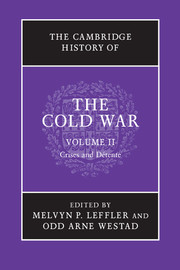Book contents
- Frontmatter
- 1 Grand strategies in the Cold War
- 2 Identity and the Cold War
- 3 Economic aspects of the Cold War, 1962–1975
- 4 The Cuban missile crisis
- 5 Nuclear competition in an era of stalemate, 1963–1975
- 6 US foreign policy from Kennedy to Johnson
- 7 Soviet foreign policy, 1962–1975
- 8 France, “Gaullism,” and the Cold War
- 9 European integration and the Cold War
- 10 Détente in Europe, 1962–1975
- 11 Eastern Europe: Stalinism to Solidarity
- 12 The Cold War and the transformation of the Mediterranean, 1960–1975
- 13 The Cold War in the Third World, 1963–1975
- 14 The Indochina wars and the Cold War, 1945–1975
- 15 The Cold War in the Middle East: Suez crisis to Camp David Accords
- 16 Cuba and the Cold War, 1959–1980
- 17 The Sino-Soviet split
- 18 Détente in the Nixon–Ford years, 1969–1976
- 19 Nuclear proliferation and non-proliferation during the Cold War
- 20 Intelligence in the Cold War
- 21 Reading, viewing, and tuning in to the Cold War
- 22 Counter-cultures: the rebellions against the Cold War order, 1965–1975
- 23 The structure of great power politics, 1963–1975
- 24 The Cold War and the social and economic history of the twentieth century
- Bibliographical essay
- Index
- References
5 - Nuclear competition in an era of stalemate, 1963–1975
Published online by Cambridge University Press: 28 September 2010
- Frontmatter
- 1 Grand strategies in the Cold War
- 2 Identity and the Cold War
- 3 Economic aspects of the Cold War, 1962–1975
- 4 The Cuban missile crisis
- 5 Nuclear competition in an era of stalemate, 1963–1975
- 6 US foreign policy from Kennedy to Johnson
- 7 Soviet foreign policy, 1962–1975
- 8 France, “Gaullism,” and the Cold War
- 9 European integration and the Cold War
- 10 Détente in Europe, 1962–1975
- 11 Eastern Europe: Stalinism to Solidarity
- 12 The Cold War and the transformation of the Mediterranean, 1960–1975
- 13 The Cold War in the Third World, 1963–1975
- 14 The Indochina wars and the Cold War, 1945–1975
- 15 The Cold War in the Middle East: Suez crisis to Camp David Accords
- 16 Cuba and the Cold War, 1959–1980
- 17 The Sino-Soviet split
- 18 Détente in the Nixon–Ford years, 1969–1976
- 19 Nuclear proliferation and non-proliferation during the Cold War
- 20 Intelligence in the Cold War
- 21 Reading, viewing, and tuning in to the Cold War
- 22 Counter-cultures: the rebellions against the Cold War order, 1965–1975
- 23 The structure of great power politics, 1963–1975
- 24 The Cold War and the social and economic history of the twentieth century
- Bibliographical essay
- Index
- References
Summary
During the years after the Cuban missile crisis, both superpowers treaded more warily to avoid direct confrontations, but traditional Cold War concerns kept them expanding their nuclear arsenals and preparing for the possibility of World War III. Motivated by fear and suspicion, but also by diplomatic and political purposes, both Moscow and Washington invested huge sums in thousands of nuclear weapons and intercontinental delivery systems. During the 1960s, the United States deployed over a thousand intercontinental ballistic missiles (ICBM), hundreds of submarine-launched ballistic missiles (SLBMs), and took the arms race in a new qualitative direction by developing accurate multiple independently targetable re-entry vehicles (MIRVs). The Soviets, determined never to be outmatched again in a crisis, began to field a formidable ICBM force. Before Moscow reached strategic parity with Washington, and ended US nuclear supremacy, however, a stalemate had emerged, where neither side could launch a preemptive strike to gain a military advantage without incurring horrific losses. While the leaders of the superpowers recognized that nuclear weapons were militarily unusable, except in the most extreme circumstances, they nevertheless wanted them for deterrence and for diplomatic leverage.
In Europe, the cockpit of Cold War rivalries, apprehensions about military force imbalances and fears of nuclear blackmail and first strikes gave nuclear weapons a central role in alliance policies and politics. To validate security guarantees and to deter political and military threats, both the Soviet Union and the United States stockpiled thousands of tactical nuclear weapons on European soil.
- Type
- Chapter
- Information
- The Cambridge History of the Cold War , pp. 88 - 111Publisher: Cambridge University PressPrint publication year: 2010
References
- 4
- Cited by

